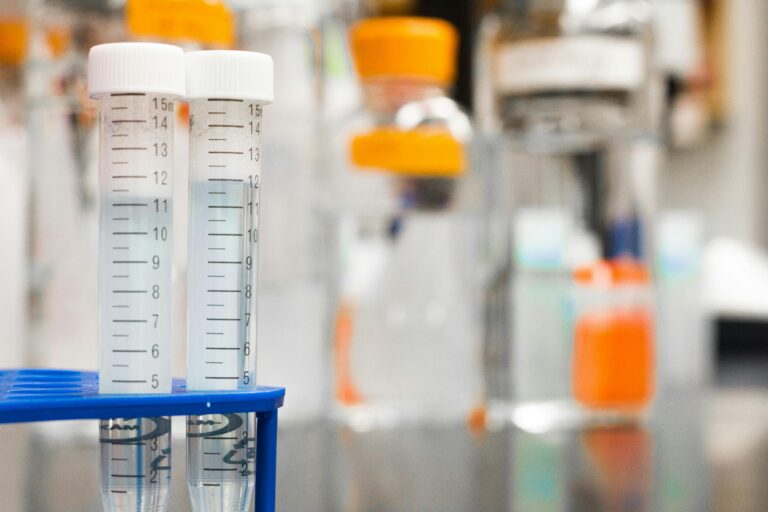- Free shipping on every order
- Same day dispatch
- Price beat guarantee
Menu
Blog Silicone Wristbands for Chemical Exposure Monitoring

Silicone Wristbands are becoming a useful tool in chemical exposure monitoring, they work by absorbing chemicals from the environment, which can later be measured in a lab by scientists.
Chemical exposure monitoring involves the measurement of chemicals that people can be exposed to, whether at work or in their everyday lives. The chemicals that are measured are often those thought to have detrimental effects on health and thus are important to identify and measure.
Traditional approaches to chemical monitoring involve measuring levels in blood and urine tests to detect the amount of certain chemicals that reach our bodies.
In recent times, new methods of monitoring, including the use of silicone wristbands, have been researched and found to be a non-invasive and convenient alternative for chemical exposure measurement.
In this article, we will discuss how silicone wristbands can be used to detect chemicals in the environment, and how this tool is revolutionising health and workplace data.
The silicone used in silicone wristbands is made of polymers that are linked together to form a flexible structure. This type of silicone polymer, called PDMS, is made by bonding silicone, oxygen, carbon and hydrogen together to methyl groups.
Silicone has some unique features that make it great for use in wristbands and, maybe surprisingly, chemical exposure monitoring.
First up, silicone is biocompatible, meaning it is safe for you to wear on your skin. It’s also waterproof, flexible, and non-irritating for most people, even when worn over long periods.
This chemical structure in these wristbands means that they are both flexible and porous. Whilst you won’t notice the porosity, it means that it can absorb chemicals from the environment, including Semi-Volatile Organic Compounds, also called SVOCs. Silicone’s natural permeability means that it will absorb and store these chemicals, allowing them to be detected and measured by lab workers.
Because the silicone polymers used in wristbands can absorb chemical compounds from the environment, the chemicals detected can give scientists an idea of chemical exposure over time.
PDMS can both bind to and incorporate certain chemicals that have a low molecular weight and are non-polar in their chemical nature. This includes certain molecules, such as SVOCs, that can penetrate the silicone polymer structure and be absorbed.
SVOCs (Semi-Volatile Organic Compounds) are found in substances such as pesticides, flame retardants, flooring and certain gas emissions. These chemicals stay in the environment for long periods and can result in both environmental and health concerns.
PDMS can uptake chemicals, including:
After being worn, the wristbands are soaked in ethanol for up to 90 hours in the lab. This allows the chemicals that have accumulated on the wristbands to be freed from the silicone structure. The chemicals can then be detected using sophisticated methods such as gas chromatography and mass spectrometry.
Chemical analysis has been shown to detect up to 49 compounds that are bound to the silicone in the wristbands, ranging from caffeine, right through to pesticides.
When worn over time, scientists can track a number of chemicals and estimate the extent to which the chemicals have been present in the environment, if at all. Although they can make estimates of these things, they cannot formulate a timeline, meaning it may not be clear when the exposures happened.
Silicone can absorb certain chemicals that are present in the environment, and gives an insight into how exposed the wearer has been to certain chemicals in their day-to-day.
Silicone polymers can bind to chemicals in that area present in the surrounding air, as well as when in direct physical contact. When worn every day, the wristbands can absorb chemicals from both the air and through direct physical contact. This gives scientists a good idea of what chemicals are being inhaled by the wearer or absorbed through the skin.
Unlike other testing methods that may pick up the occasional exposure, the continuous monitoring allows for a full picture of environmental exposures through a number of routes.
This helps not only with SVOCs environmental monitoring but also allows for personal monitoring of toxic chemicals.
Silicone wristbands can be used as a tool for passive sampling. Passive sampling involves absorption and adsorption of chemicals that are present in the environment, and gives scientists a good idea of chemical exposure over a long period of time.
These chemicals, particularly SVOCs, diffuse into the wristband’s pore structure and are stored until they can be analysed in a laboratory setting. The effectiveness of this sampling process is influenced by the size and distribution of the pores within the silicone material.
Smaller pores can enhance retention by preventing larger chemical molecules from escaping, but they may also limit the uptake of certain chemicals that require more space to diffuse effectively.
Conversely, larger pores allow for easier diffusion of a wider range of chemicals, but they may reduce retention time if the chemical molecules do not adhere strongly to the silicone matrix. The balance between pore size and chemical properties plays a crucial role in determining which substances are effectively captured and how long they remain stored before analysis.
While environmental factors, such as high airflow through venting systems, warm temperatures and humidity, will also impact the amount of chemicals that are absorbed.
Factors increasing the rate of chemical uptake include:
There are many instances in which silicone wristbands can be used to monitor exposure to certain chemicals in the environment.
Silicone wristbands can be used as part of environmental research to monitor the level of certain pollutants in the environment. This can be done by private entities, government agencies or for environmental research.
Occupational exposure, otherwise known as exposure to chemicals in your workplace, can be measured using silicone wristbands. This can be done by auditors, workers and employers to check that exposure to harmful chemicals is minimised, and stays within healthy limits.
One of the breakthrough approaches to personal chemical exposure has been passive monitoring, using tools such as silicone wristbands that can be worn every day. This allows for the detection of pesticides, chemicals in personal care products, and certain chemicals in the air that may impact our health from day to day.
This can provide a more detailed picture of disease processes that may be exacerbated by exposure to certain chemicals in the environment.
On a larger scale, it can also be used in epidemiological studies to track certain diseases and link them to chemical exposures. Studies have already studied the amount of chemical exposure in children by getting them to wear silicone wristbands and studying their chemical exposures.
There are two ways in which silicone wristbands in chemical monitoring can help trace a link between exposure and adverse health outcomes.
On a smaller scale, individuals can gain valuable insight into which chemicals they are exposed to and to what extent. Certain chemicals that can be detected through silicone monitoring have been associated with certain conditions, which allows people to make exposure-disease associations.
For example, exposure to Organophosphate flame retardants has been found to have detrimental effects on the liver and increase the risk of depression in new mothers. These flame retardants can be monitored with the use of silicone wristbands and may be a helpful tool when it comes to bringing in preventative measures and managing the risk of exposure.
On a larger scale, public health policies can be informed by mass data collected using wristbands. This allows epidemiologists to find the links between chemical exposure and adverse health outcomes before intervening. It can also be used in interventional studies to help make links between a reduction in chemical exposure and potential health benefits.
The clearest benefit of utilising silicone wristbands for chemical monitoring is ease of use and cost-effectiveness.
Traditional methods to estimate chemical exposure in people involve biomonitoring, which requires blood or urine collection to detect chemicals in the body. Silicone monitoring, on the other hand, is non-invasive and simply involves extracting the chemicals that have been absorbed through the wristband.
The wristbands can pick up chemicals from multiple exposure pathways, such as on the skin and in the air. This makes it easy to use and can help with biomonitoring through both air sampling and dermal exposures, giving them an edge over other passive air sampling methods that are not able to pick up on both air and dermal exposures.
The wristbands themselves are easy to use and do not require high levels of user compliance.
They are also cheaper alternatives to other chemical detection methods, and are available to buy en masse at discounted rates.
Whilst there are certain benefits to using silicone wristbands in chemical exposure monitoring, there are some drawbacks to be aware of.
The wristbands can detect the average exposure to chemicals but have poor temporal resolution. This means that when it comes to data interpretation, it is difficult to know when the chemical exposure has occurred and over what period. This may be an issue if someone is exposed to a chemical all at once, as it is difficult to establish when this has occurred using the data provided by the wristband.
The silicone is also not designed to capture particle-bound chemicals, which are chemicals that are bound to dust or aerosols. These are usually too large to bind to the silicone pores and may not be picked up as exposures.
Another drawback is the sampling bias and the need for more sophisticated data interpretation, which is an ongoing process.
Chemicals in the environment impact everyone in the general public. However, some populations are more at risk of chemical exposure or are more likely to have negative outcomes from exposures, compared to other people, and thus may benefit more.
For example, firefighters are exposed to PBDE flame retardants at much higher rates than other people. Monitoring these levels of exposure using tools such as silicone wristbands is important for various reasons, as for example, exposure to these chemicals has been shown to have negative impacts on multiple organ systems.
Other populations, such as children and pregnant women, may also benefit greatly from chemical exposure monitoring. Children, for example, are exposed to toxic VOCs in day care facilities. Whereas a baby’s growth may be impacted if their pregnant mother was exposed to these compounds. Knowing these populations’ chemical exposures may help reduce these risks and improve health outcomes. Whilst some populations may be at higher risk, the general public, pet owners and other people also benefit from knowing their levels of chemical exposure.
Silicone wristbands are comfortable to wear, non-toxic and waterproof. This means that they can easily be worn for extended periods and give a representative sample of exposure to chemicals over a long period, rather than a small snapshot.
Their flexible nature means they can be worn by people of all activity levels and have great sleep compatibility. This increases their duration of wear and helps obtain continuous exposure samples.
Silicone’s waterproof properties also mean they can be worn showering, and swimming, and never need to be taken off.
For silicone wristbands to be used for chemical monitoring, they must be manufactured in a specific manner.
Standardisation of wristband manufacturing means that the samples collected from environmental chemical exposure can be trusted and attributed only to chemical exposure rather than variability in the wristband manufacturing process.
Calibration is an important part of this process. Calibration involves exposing a wristband to a set amount of chemical and then leaving it for a set amount of time. The amount of chemical that the silicone takes up is then measured to see how much the wristband can absorb. This information is then used to accurately calculate how much chemical is present in the environment.
The last step in the quality control process involves using blank samples, straight from the manufacturing factory, in order to detect any background levels of chemicals that are present before the wristband is worn.
All these practices help with quality assurance and data reliability.
There are certain health guidelines that need to be met at workplaces, which chemical monitoring can help with. In Australia, this includes the Workplace Exposure Standards for Airborne Contaminants (WESs) and Safe Work Australia, which outline acceptable standards of chemical exposures.
Detecting exposure with silicone wristbands may help workplace compliance with these standards.
On the other hand, there are certain regulations that wristbands themselves need to meet. This includes meeting the obligations and safety standards outlined under the Australian Consumer Law that state that products, including silicone wristbands, may not pose a health risk when worn.
When it comes to the ethics around using wristbands for the detection of chemical exposure in human studies, there are very strict guidelines involving research in human and other animal subjects.

Data provided by silicone wristbands provides valuable insight into exposure-disease associations. This information can help guide public health policy and be used in international studies looking at the effect of chemical exposure on health outcomes.
Silicone wristbands can provide information on a wide range of potential chemical exposures that may be harmful. Collecting data from people who have been exposed to high levels of certain chemicals and monitoring their health can help determine whether that chemical is related to their health condition.
Such information can be helpful for treatment, diagnosis, and on a wider scale, help in recognising a pattern that can be addressed by public health measures.
These studies can contribute to research in areas such as:
Silicone wristbands offer a revolutionary way of chemical exposure monitoring. Because of the unique structure of the silicone polymer, certain chemicals that are present both in the air and on the skin can bind to the silicone structure.
The levels of chemicals absorbed by the wristbands can be analysed in the lab, and this gives us an idea of the extent of exposure to certain chemicals.
Some of these chemicals have been found to impact health outcomes and provide valuable insights into how chemical exposure is affecting our health.
Silicone wristbands can also be used in environmental research, occupational health and personal health studies to help understand and manage chemical exposure risks in a non-invasive and cost-effective manner.
If you’re interested in how silicone wristbands can provide you with the insight you’re after, contact us at 08 8363 4850 or [email protected] to discuss these options further.


Join our mailing list to receive product information, endless inspiration and 10% off your next order!


Monday – Friday 8:30 AM-8:30 PM
Saturday 10:00 AM-5:00 PM
Sunday CLOSED
38 Little Rundle Street Kent Town SA 5067
08 8363 4850
ABN: 62 239 772 879
The Wristband Co. is located on the traditional lands for the Kaurna people, and we respect their spiritual relationship with their Country. We also acknowledge the Kaurna people as the custodians of the Adelaide region and that their cultural and heritage beliefs are still as important to the living Kaurna people today.
Payments Accepted